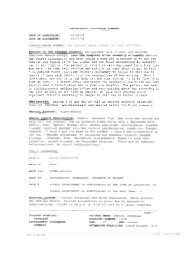C - Organized Mobbing
C - Organized Mobbing
C - Organized Mobbing
Create successful ePaper yourself
Turn your PDF publications into a flip-book with our unique Google optimized e-Paper software.
Atternptlng to Know and Control the Opposition 505<br />
poppe about the letter. Therein, Poppe IS deplcted as hesitant about what<br />
to make of the letter. She is said to have emphasized the importance of a<br />
E democratic atmosphere in the group but also to have shown considerable<br />
anger toward the letter by burning it upon receipt.36 Another two days later,<br />
with the help of a bug installed in the apartment of Lutz and Bettina Rathe-<br />
now, the Stasi eavesdropped on a conversation between Bettina Rathenow<br />
and Ulrike Poppe. The two have, according to the eavesdropping protocol,37<br />
led a frank and open discussion about what was going on with the group<br />
during Poppe's imprisonment. Rathenow is said to have assured Poppe, by<br />
pointing to the language of the letter, that she has no doubt that it must<br />
be a Stasi fabrication. Perhaps not so surprisingly, then, Stasi officer Jager<br />
had to report yet another two days later about the account of h s informant<br />
Hager concerning a meeting she had attended on February 27 with a larger<br />
group, which this time included Bohley and Poppe. This report makes clear<br />
that the Stasi's effort to decompose the group created a temporary friction<br />
at best, and that the positive assessment of the anonymous letter's effects<br />
were premature. Even though Jager reports that the evening began with an<br />
open airing of the confict, several members, including the secret informant,<br />
are said to have calmly defended the necessity of some measure of secrecy<br />
within the group. Three other members close to Poppe and Bohley, among<br />
them Bettina Rathenow, are credited with the suggestion that the letter was<br />
a Stasi forgery launched to divide the group, thus takmg a position against<br />
the claims made in the anonymous letter. The Stasi report suggests that after<br />
several members of the group had declared in the meeting to have destroyed<br />
the letter for this reason, the correct interpretation seems to have prevailed<br />
in the discussion. This does not mean that the conflicts were not taken<br />
seriously. Quite to the contrary, according to the Stasi report, the women<br />
proposed more common activities to get to know one another better on<br />
a more personal level. Clearly the women were eager to engage in trust-<br />
building exercises. In keeping with its PID/PUT/"opposition" theory the<br />
Stasi, however, interpreted the women's plans to get to know each other<br />
better as an effort to differentiate friend from foe (using the Stasi's own<br />
term-"who-is-who reconnaissance"). One member of the women's group<br />
1<br />
reports.' Needless to say that the informant often only reports' or even reports3 with conse-<br />
quences for everybody further down the stream of information processing.<br />
36. MDA, OV "Zirkel" MR XX/2 "Bericht zum Treff des IMB "Karin Lenz" am 24.2.84" dated<br />
25.2.84.<br />
37. Since, as every ethnographer knows, verbatim transcriptions are incredibly time consum-<br />
lng, the Stasi's department 26 (interestingly always set in Arabic numerals), the unit responsible<br />
for eavesdropping operations, has typically provided only summarizing reports about the ver-<br />
bal exchanges recorded on tape. One can therefore not assume that the language reported b~<br />
the Stasi was in fact the language used by the spied upon persons.






